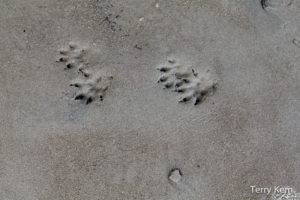The American Mink
by Linda Spielman
The mink is a medium sized mustelid, related to weasels, otters, and wolverines. It hunts fish, crayfish, crabs, frogs, muskrats, waterfowl, water snakes, and aquatic invertebrates, and these foods are supplemented with mice, voles, rabbits, squirrels, snakes, lizards, and ground-nesting birds. The mink’s luxurious pelt has a lot to do with its success. The dense undercoat provides superb insulation and the covering layer of guard hairs keeps the inner layers dry, so the animal is comfortable in or out of water and in any weather.
But its pelt was nearly the mink’s undoing. Before Europeans arrived in North America, mink ranged from the tropics to the tundra, but with the coming of the colonizers mink were relentlessly trapped for their fur. Laws regulating the harvest of fur-bearing animals slowed down the slaughter, but another crisis—water pollution—was even more devastating. Because they are at the top of the food web, mink concentrate toxins in their bodies. As streams and lakes became more and more polluted during the twentieth century, mink disappeared from many otherwise suitable habitats. It has only been in the last decades that cleaner waterways have allowed these formerly abundant animals to return.
Hammond Hill, like the rest of our region, now supports a healthy population of mink. Although they are water-loving creatures, mink may follow small streams up onto the highest elevations. In winter they do much of their hunting on land and can range far from water. Their innate wariness is combined with a bold inquisitiveness, and it’s not unusual for hikers in the Hammond Hill area to catch sight of a sleek, dark animal bounding through the forest. I once saw a mink sitting on a protruding log surrounded by water, and I spent several minutes watching it. It studied me carefully in turn and then gracefully dove into the water and disappeared. With their dark brown fur unbroken by any white areas, mink are easily distinguished from weasels. Fishers are larger but similar in outline and color and at a distance can be hard to differentiate from mink, but the fisher’s fur is fluffier and often has a grizzled or grayish tinge.
The most easily obtained evidence of the mink’s presence comes from its tracks. Like all mustelids, each foot bears five toes arranged in a lopsided crescent
 like those in the photo. Their prints can be found in warm weather in silty patches along streams or on the muddy shorelines of marshes and ponds. You may see how the mink likes to patrol the shoreline and duck into any overhanging tangle or narrow cleft to investigate for possible prey. Snow tracking reveals even more about the mink’s captivating personality. I once came upon a small slope draped with several mink slides (yes, mink slide much the way otters do). When I looked closely, I saw that a mink had tobogganed down the decline, run around and back up, and slid down again.
like those in the photo. Their prints can be found in warm weather in silty patches along streams or on the muddy shorelines of marshes and ponds. You may see how the mink likes to patrol the shoreline and duck into any overhanging tangle or narrow cleft to investigate for possible prey. Snow tracking reveals even more about the mink’s captivating personality. I once came upon a small slope draped with several mink slides (yes, mink slide much the way otters do). When I looked closely, I saw that a mink had tobogganed down the decline, run around and back up, and slid down again.
